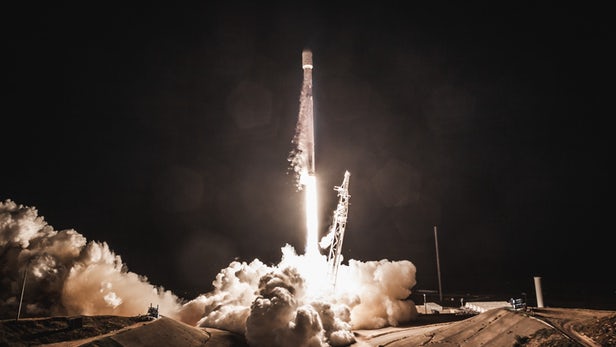SpaceX is in communication with all but three of 60 Starlink satellites one month after launch
It’s been over a month since SpaceX launched its first batch of 60 internet-beaming satellites for the company’s massive Starlink activity, and everything except three of the satellites appear to function as planned. At first, SpaceX had the option to speak with each of the 60 spacecraft after launch, however in the long run lost correspondence with three outliers. The uncommunicative trio will continue to orbit the Earth for a time, but will eventually get pulled down toward our planet by gravity, where they will burn up in the atmosphere.
The remainder of the 57 satellites have been filling in as expected, as per the organization. Forty-five of the satellites have raised their altitudes with their installed engines and have achieved their last planned circles of 342 miles (550 kilometers) up. Five of the satellites are still trying to raising their circles, and another five are experiencing extra frameworks checks before they raise their orbits. As for the remaining two satellites, SpaceX intentionally fired their onboard thrusters with the goal of crashing them into the planet’s atmosphere. There wasn’t anything wrong with those satellites — the company just wanted to test the de-orbiting process.
That means that five total satellites are headed into a fiery grave. “Due to their design and low orbital position, all five deorbiting satellites will disintegrate once they enter Earth’s atmosphere in support of SpaceX’s commitment to a clean space environment,” SpaceX said in a statement.
These 60 satellites, launched on May 23rd, were only the first of about 12,000 satellites that SpaceX plans to put into orbit around Earth. The company got authorization from the Federal Communications Commission to dispatch one group of 4,409 satellites, trailed by another star grouping of 7,518. The spacecraft are intended to fly in a moderately low orbit over the planet and beam internet coverage to the ground below, providing service to all areas of the globe. The idea is to provide coverage to rural or remote areas, where laying fiber isn’t an option, as well as provide another internet service option to customers.
The company will before long begin utilizing its juvenile Starlink heavenly body to stream recordings and play high–bandwidth video games, so as to see exactly how much slack time there is in the service. In any case, But the company says it will also implement changes on future spacecraft based on this launch. “While we are pleased with the performance of the satellites so far, SpaceX will continue to push the operational capabilities of the satellites to inform future iterations,” SpaceX said in a statement.
The way that three of the SpaceX Starlink satellites halted correspondence may start more worry among the space network. A few specialists are now stressed over how the heavenly body will add to the space flotsam and jetsam issue. Currently there are 2,000 operational satellites in orbit around Earth, according to the latest figures from the European Space Agency, and the completed Starlink constellation will drastically add to that number. Such a boost could increase the risk of collisions of satellites in space, creating more debris that could further threaten other spacecraft. A study done by NASA argued that 99 percent of all of the satellites in these massive constellations must be taken out of orbit within five years in order to keep the risk of in-space collisions low. And if a company cannot communicate with a satellite, it cannot control the vehicle and take it out of orbit.
However, SpaceX says it has implemented various design and system changes to ensure that the company doesn’t pollute the space environment. SpaceX CEO Elon Musk said that the Starlink spacecraft use data from the US Air Force on the positions of other satellites in space, in order to move out of the way and avoid collisions with nearby objects. And in April, the FCC approved SpaceX’s request to fly its initial batch of Starlink satellites closer to Earth, so that they would be dragged downward and fall out of orbit more quickly.
Astronomy experts are also concerned. Light and radio astronomers have raised concerns about how the Starlink constellation could affect observations of the Universe. When the first 60 satellites launched, the spacecraft turned out to be much brighter in the sky than anticipated, and scientists warned that the light reflected off these vehicles could mess up their long-exposure images of the sky. Additionally, radio astronomers were also suspicious that the frequencies that these satellites operate on could cross with the frequencies scientists use to study distant objects in space.
SpaceX says it has been working with leading astronomy groups to figure out ways to mitigate any potential impacts on space science. And top astronomy groups have put out statements saying that they have been in proactive talks with the company.
In the meantime, it’s unclear when the next launch of Starlink satellites will occur. Musk said the company will continue to launch batches of 60 satellites at a time, with the goal of getting between 1,000 to 2,000 spacecraft up each year. It should take about 24 launches to reach global internet coverage, according to Musk.

